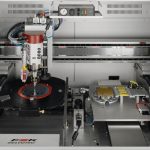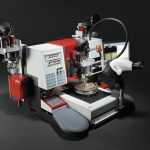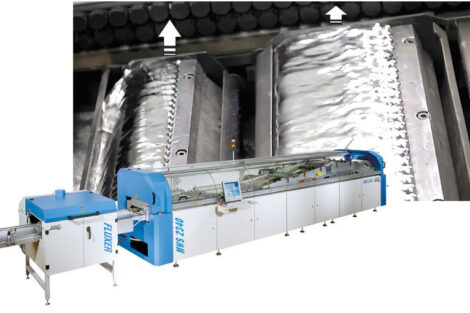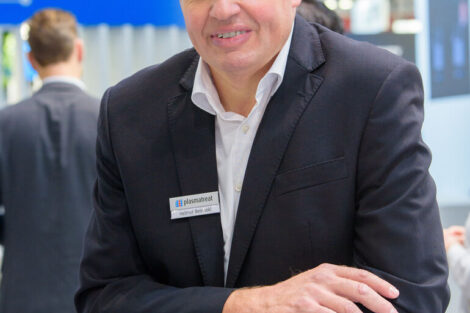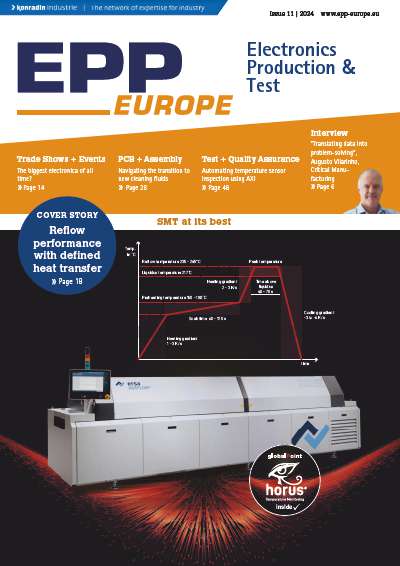The new pride and joy is a brand-new development and carries the futuristic name Wega 80XX. Is it a die-bonder, a pick-and-place machine, a dispenser, maybe even a wire-bonder or a bond tester? “Whatever you like”, explains a beaming Siegfried Seidl, General Manager at F&K Delvotec Austria in Braunau on the Inn river. The latest addition to the product family seamlessly complements the modular system which in the last 10 years has bestowed a series of successes upon the Austrian branch of the company group, most recently with the Desktop Micro Factory 56XX.
Dr. Josef Sedlmair, F&K Delvotec, Austria
To think that everything started modestly enough: it was 1993 when one of the last German semiconductor manufacturers shut down its packaging back-end for discretes in Braunau and moved operations to the Far East. 200 employees, many of them perfectly familiar with the company’s equipment and highly qualified in die- and wire-bonding in many years of experience, were looking for new jobs. Not quite easy in their home area, the Innviertel, which is blessed with many tourist attractions but sadly lacking electronic manufacturers. F&K Delvotec in Munich would have like nothing better than hiring the specialists, but the Austrians were reluctant to move house from their pleasant countryside.
By a happy coincidence, the town of Braunau had just established a technology center which provided space. Two rooms were rented and 4 employees started turning an old dream of the two owners of the company, Dr Farhad Farassat and Said Kazemi, into reality: a semi-automatic wire-bonder which was designed to complement their fully automatic machines on the low-volume side. The first model, the wedge-wedge bonder 5430, shared many crucial components from its fully automatic sister model 6319 and became an instant success. This was mainly thanks to the identical bondheads – thus a customer could develop a circuit, for instance, on the desktop bonder 5430 and then transfer the job without much ado to the fully automatic bonder 6319 once the volume needed ramping up. The other way round was also no trouble: repairs or small and phase-out lots could migrate happily to the 5430 without blocking fully automatic production equipment. Bond quality on the finished products is excellent because the 5430 works semi-automatically, meaning it can produce an entire wire loop under program control. Operator influence is therefore minimized. In short order, three more models in this family followed, for heavy wire, gold-ball-bonding and deep-access wedge-bonding. They not only share the same basis but can also be converted with minimal effort at the customer site.
Within a few years more than 300 bonders had been sold, and the small band around Siegfried Seidl, who in the meantime had become General Manager, outgrew the rented rooms in the technology center. In 2001, seven years after the modest beginnings, they moved into their own, newly-built facility just across the road. By that time, over one third of staff were engineers working in R&D and unleashed the next growth wave. It was fed by the product series 53XX, a family of desktop bonders for manual operation in the price range below the 54XX. Extremely straightforward handling, a color monitor and a highly attractive design, but most of all, excellent bond quality assured the next big success. Within a short time period, more than 100 bonders were installed worldwide, even in the Far East and the USA, where competition is supposed to be strongest.
The most successful development so far, however, came next: the model series 56XX, a semi- and fully automatic bonder for lab and pilot production. It boasts a fully programmable X-Y-table with micro-PC-controller and even an optional pattern recognition for fully automatic work. The chief attraction is that all bond-heads can be exchanged by the user within minutes, just by unplugging them. There are four different versions to choose from, just like in the model 54XX: for gold-ball-bonding, for thin-wire wedge-wedge, another version of that for ribbon or vertical wire feeding, and finally for heavy wire. A special version of the latter even manages the latest technology with heavy aluminium ribbons. But it is not only bondheads that the 56XX handles: for this machine there are also test heads for pull- and shear-testing of wirebonds and chips. They, too, are just as easily switched by the user. “Internally we call the 56XX series also Hydra, because it has nine heads, just like the Greek mythical creature,” explains an amused Siegfried Seidl. “Our hydra is somewhat different, though: when you remove one head, you don’t have two heads growing back. But still you can take care of the head exchange within a few minutes. And our customers find that fabulous, so to speak”. The bonder’s success proves the Austrians right. Within four years they were able to install around 300 bonders in Europe alone, with an average of three heads each.
The mountain came to the prophet
What is behind this great success? “Our Hydra 56XX closes a big gap. Up to now, a user only had two choices – on the one hand a lab bonder which is simple and flexible to use but can only be as good as the operator, on the other hand a fully automatic bonder which produces top quality at high speed but takes much longer to set up for a product change. Our 56XX is placed exactly in between and will deliver a sample product within minutes. But just as well it can produce a small series when running in automatic mode. The quality is always excellent because there is little or no operator influence.” Add the convertibility to other bond technologies – a customer who wants to start heavy wire bonding because he needs to process power components does not have to invest in a new bonder. All he does is purchase the additional bond-head. Even the training is no big trouble, because the bonder software stays the same, and only the additional aspects of heavy-wire bonding have to be trained. This advantage really shows off the strength of the system approach by the company, observes Dr Farhad Farassat who is the majority owner in both companies. “Even though we have no more than 150 employees world-wide, we are the only bonder manufacturer world-wide to offer all wire-bond technologies – gold-ball, thin-wire wedge-wedge and heavy-wire.” The companies in the group, meanwhile four of them, have organized themselves so that fully automatic bonders for volume production are designed and built in Ottobrunn just outside of Munich. The two subsidiaries in Singapore and near Los Angeles serve the important markets in the Far East and in North and Central America by offering sales, demos and service. Braunau, by contrast, focuses on small volumes, meaning bonders for lab, pilot production and repair; on new technologies and special requests such as process development, and finally on testers for pull- and shear-tests. In the latter area they just landed a major coup with a fully automatic test-head, because this makes the 56XX the first tester to safely exclude operator interference during testing which is an important goal of automobile manufacturers.
Product line-up
“Originally we had plans for our many years of experience to make their way into a truly universal die-bonder for special jobs, after having spun off our business unit for standard automatic die-bonders for mass production in 2006”, Dr Farassat looks back, and Seidl continues: “We wanted to tailor a piece of equipment for the European and US market which would help our customers manufacture a broad mix of top-quality parts at small lot sizes. This high-mix-low-volume challenge is very typical for Europe and the US. The central demand for the bonder design was that it was supposed to take less than 10 minutes from the drawing to the first produced part. The idea is that you’ll have already produced 100 to 500 parts on day one, while a standard automatic bonder will almost take up the same amount of time just for setup and adjustment. If you consider that typical lot sizes for such high-value products as sensors, medical or microwave circuits are often 100 pieces or less, you can see our thinking”.
That was not the whole story, however. The people at F&K Delvotec Austria did not stop at simply turning a linear-motor gantry, albeit one with a gigantic working range of 1000 mm width and 160 mm depth, into a die-bonder. Rather, they decided to build on the strengths of the 56XX family and set their sights on exchangeable bond-heads and optional modules. The basic version contains a die-bond head with built-in target camera and dispenser. Just as in the 56XX, though, this bond-head is very easy to exchange so that future versions of the 80XX will benefit from test heads or even wire-bond heads. A user starting out today by investing in a pick-and-place bonder for small lots of high-value products will have no trouble tomorrow to move on into testing huge circuit boards of up to 1 m width or bonding them with heavy wire. And even though the Wega 80XX is, for the moment, designed for manual loading and unloading, there is no obstacle to fitting several different automatic parts handling systems. The concept is flexible enough for all this – not least thanks to the software which was developed from scratch and is entirely and uncompromisingly modular from top to bottom. This rigorous approach ensures that any and all new hardware components to be added, or new functionalities to be implemented, do not cause interactions with existing program parts – normally a well-known headache for any programmer of an open platform system. What this boils down to is that even a completely new bond-head for applications that don’t yet exist today would not be a big challenge to develop and integrate.
It is only consequent that the new all-rounder is termed Micro Factory Wega 80XX, continuing the earlier Desktop Micro Factory 56XX. This reflects also on its physical dimensions which have grown along with the larger working area. After all the Wega, while not exactly being a colossus, weighs in at a little over 1 ton. Some of this comes down to the highly sophisticated vibration damping concept developed for the monobody in the new double-headed wire-bonders G5.2 from the sister company in Munich. The same base frame is used in the Wega and makes sure the powerful but precise linear motors can be run at high speed even while positioning down to 1 micrometer accuracy.
And where is the journey going for the inventive Austrians? Seidl is cautious and non-committal: “Our success has a very straightforward root – we have simply listened to what our customers wanted, distilled these wishes into what we can realize and built just the right machines for that. In that sense we owe our success to our customers.” And Dr Farassat philosophizes further: “It is impossible, here in expensive Europe, to produce at low cost. So our machines must offer extra value to our customers, be it in innovative technology, highest quality or exceptional versatility. Our automatic bond tester 5600C and now the Micro Factory Wega 80XX are living proofs that we are not running out of ideas by a long way.”
Not surprising, perhaps, that the success story continues and the company keeps growing. The building is bursting at every seam and an extension is already begun. Old and new employees are looking forward to filling up an additional 550 square meters of production floor by early next year – just in time for the tenth anniversary of the first building.
Zusammenfassung
Mit der neuen Generation an Bondmaschinen, Wega 80xx, festigt F&K Delvotec Semiconductor im österreichischen Braunau seine Stellung auf dem Markt der Die- und Wirebonder. Das Multitalent lässt sich als Diebonder, Large Area Drahtbonder oder Bondtester einsetzen.
Grâce à la nouvelle génération de machines à souder, Wega 80xx, F&K Delvotec Semiconductor (Braunau, Autriche) renforce sa position sur le marché des microsoudeuses de puces et des machines de liaison par fil. Ces machines polyvalentes peuvent être utilisées en tant que microsoudeuses de puces, machines de liaison par fil pour grande surface ou en tant que testeurs de liaisons.
Share:





